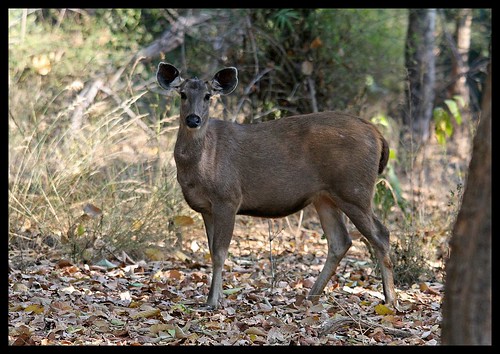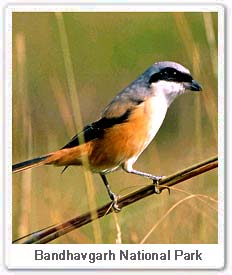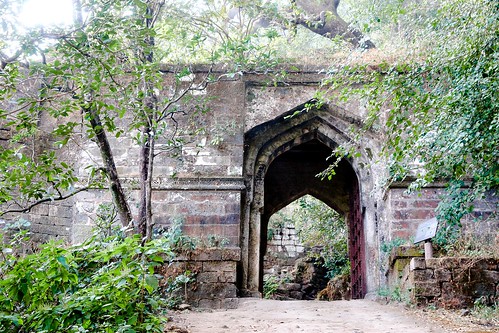 Bandhavgarh National Park is one of the wild life sanctuaries in the Indian state Madhya Pradesh.This wild life park derived its very name from an ancient fort in the area. Bandhawgarh National Park belongs to the Vindhyan mountain ranges of central India and it boasts to have the highest density of tiger population in the country. Now there are about 46 to 52 tigers one can spot here. The Bandhavgarh national park is a jungle consisting mainly of sal trees. Only on higer sides the vegetation changes to sali, saj, saja, dhobin etc.In the northern region of the park, there are vast stretches of grasslands and bamboo forests.A lot of this is what appears to be young bamboo, which can be seen from it's green and slim appearance.This northern region of the national park also consists of a series of rocky ridges with deep crevices cut by perennial streams.In the south of the park, the extensions, which were included into the park in 1986, consist of low hills covered with forest but interspersed with grasslands that were formerly agricultural land. The central portion of the park, which consists of the original 106 square kilometers and the fort, is still the main sighting area. The Bandhavgarh National Park is spread over on area of 448 sq km with a cross area of 105 sq km. At the center of the park is the bandhavgarh hill, rising 811 meters above sea level and surrounding it are a sloping valleys, These valleys end in small, swampy meadows locally known as “bohera”.Bandhavgarh was declared a national park in 1968.
Bandhavgarh National Park is one of the wild life sanctuaries in the Indian state Madhya Pradesh.This wild life park derived its very name from an ancient fort in the area. Bandhawgarh National Park belongs to the Vindhyan mountain ranges of central India and it boasts to have the highest density of tiger population in the country. Now there are about 46 to 52 tigers one can spot here. The Bandhavgarh national park is a jungle consisting mainly of sal trees. Only on higer sides the vegetation changes to sali, saj, saja, dhobin etc.In the northern region of the park, there are vast stretches of grasslands and bamboo forests.A lot of this is what appears to be young bamboo, which can be seen from it's green and slim appearance.This northern region of the national park also consists of a series of rocky ridges with deep crevices cut by perennial streams.In the south of the park, the extensions, which were included into the park in 1986, consist of low hills covered with forest but interspersed with grasslands that were formerly agricultural land. The central portion of the park, which consists of the original 106 square kilometers and the fort, is still the main sighting area. The Bandhavgarh National Park is spread over on area of 448 sq km with a cross area of 105 sq km. At the center of the park is the bandhavgarh hill, rising 811 meters above sea level and surrounding it are a sloping valleys, These valleys end in small, swampy meadows locally known as “bohera”.Bandhavgarh was declared a national park in 1968.
There are more than 22 species of mammals and 250 species of birds. Common Langurs and Rhesus Macaque represent the primate group. Carnivores include the Asiatic Jackal, Bengal Fox, Sloth Bear, Ratel, Gray Mongoose, Striped Hyena, Jungle Cat, Leopard and Tiger.  The artiodactyls frequently sighted are Wild Pigs, Spotted Deer, Sambar, Chausingha, Nilgai, Chinkara and Gaur. Mammals such as Dhole, the smallIndian Civet, Palm Squirrel and Lesser Bandicoot Rat are seen occasionally. Among the herbivores, Gaur is the only coarse feederThe forests of Bandhavgarh are the white tiger jungles of the yesteryears. However, no white tigers have been reported from the wild in the last 50 years, and it is believed that less than a dozen have been seen in India in about a hundred years. And yet when white tigers were sighted, it was right here in Bandhavgarh. Charger (a tiger), an animal so named because of his habit of charging at elephants and tourists (whom he nonetheless did not harm), was the first healthy male known to be living in Bandhavgarh since the 1990s. A female known as Sita, who once appeared on the cover of National Geographic and is considered the most photographed tiger in the world, was also to be found in Bandhavgarh for many years. Most of the tigers of Bandhavgarh today are descendants of Sita and Charger.
The artiodactyls frequently sighted are Wild Pigs, Spotted Deer, Sambar, Chausingha, Nilgai, Chinkara and Gaur. Mammals such as Dhole, the smallIndian Civet, Palm Squirrel and Lesser Bandicoot Rat are seen occasionally. Among the herbivores, Gaur is the only coarse feederThe forests of Bandhavgarh are the white tiger jungles of the yesteryears. However, no white tigers have been reported from the wild in the last 50 years, and it is believed that less than a dozen have been seen in India in about a hundred years. And yet when white tigers were sighted, it was right here in Bandhavgarh. Charger (a tiger), an animal so named because of his habit of charging at elephants and tourists (whom he nonetheless did not harm), was the first healthy male known to be living in Bandhavgarh since the 1990s. A female known as Sita, who once appeared on the cover of National Geographic and is considered the most photographed tiger in the world, was also to be found in Bandhavgarh for many years. Most of the tigers of Bandhavgarh today are descendants of Sita and Charger.
Bandhavgarh National Park is also famous for bird watching. It has more than 140 bird species. The main bird species at bandhavgarh national park are white browed fantails, steppe eagles, green pigeons, grey malabar hornbills, black and white malabar hornbills (quite a rare sighting), blossom headed parakeets, parakeets, blue bearded bee eaters, green bee eaters, white bellied drongos, owls, Jerdon's and gold fronted leaf birds, minivets, woodshrikes and the lovely paradise flycatchers. The Bandhavgarh fort, enclosing an area of 560 acres, is an awesome sight. Its stands at a height of 800 meters, 300 meters higher than the surrounding area. The footpath, which also rises at quite a sharp gradient, is the preferred alternative by most visitors. This footpath begins from the left of a spot known as "Shesh Saya". At this spot lies the unique reclining, 11 meters long, statue of the Hindu God, Vishnu. In front of this statue is located a pool of spring water. This is said to be the source of the stream known as Charan Ganga, which is one of the three perennial streams flowing through the park.
It has more than 140 bird species. The main bird species at bandhavgarh national park are white browed fantails, steppe eagles, green pigeons, grey malabar hornbills, black and white malabar hornbills (quite a rare sighting), blossom headed parakeets, parakeets, blue bearded bee eaters, green bee eaters, white bellied drongos, owls, Jerdon's and gold fronted leaf birds, minivets, woodshrikes and the lovely paradise flycatchers. The Bandhavgarh fort, enclosing an area of 560 acres, is an awesome sight. Its stands at a height of 800 meters, 300 meters higher than the surrounding area. The footpath, which also rises at quite a sharp gradient, is the preferred alternative by most visitors. This footpath begins from the left of a spot known as "Shesh Saya". At this spot lies the unique reclining, 11 meters long, statue of the Hindu God, Vishnu. In front of this statue is located a pool of spring water. This is said to be the source of the stream known as Charan Ganga, which is one of the three perennial streams flowing through the park. 
Due to this round the year availability of water at this pool, it is also well frequented by animals, including tigers. You can also check the path for tiger pug marks, as this path is frequented a lot by them during the night. You will come across many other temples on your way up. Most of them depicting the various reincarnations of Lord Vishnu. Some of these reincarnations are in the form of a boar, a fish and a tortoise. One of the most overwhelming sights is the 7 meter high statue of Narasimha, the reincarnation in the form of half human, half lion. All these temples and statues date back to around the 10th century.Once inside the fort, you will be amazed at the vastness of the grasslands within. The many "lakes", which are large reservoirs of turtle filled waters, are dotted all over the fort. Once within the fort confines, it is fascinating just following the numerous tracks leading through tall grass, over rocky boulders, around lakes and ponds. For those interested in archaelogy and other related subjects, this is heaven on earth. Even for the religious minded, the number of temples in the fort comes as a very pleasant surprise. The view, from the fort, of the surrounding area can only be described as breathtaking. A walk to each of the numerous lakes within the fort boundaries is a possibility.
Bandhavgarh experiences climatic conditions that vary to opposite extremes. In winters, the bitter cold forces the visitors to put on multiple layers as protection against the biting cold. Early morning rides can be in temperature that dip below zero, once you take the windchill factor into consideration.  In the summers, it changes drastically to the opposite. It now feels uncomfortable to even sometimes put on a thin cotton t-shirt.The temperature in the winters varies from 0 to 20 degrees centigrade between November and February.In the summers, the temperatures move to the other extreme and can go up to 46 degrees centigrade. Towards late summer, it is also advisable to carry some protection, for yourself and for your cameras, from rain. Bandhavgarh has an average annual rainfall of 1200mm. The rains here give very little prior warning and it is preferable to be prepared for your own protection, as well as for your equipment. These rains, however, bring good respite from the blistering heat.
In the summers, it changes drastically to the opposite. It now feels uncomfortable to even sometimes put on a thin cotton t-shirt.The temperature in the winters varies from 0 to 20 degrees centigrade between November and February.In the summers, the temperatures move to the other extreme and can go up to 46 degrees centigrade. Towards late summer, it is also advisable to carry some protection, for yourself and for your cameras, from rain. Bandhavgarh has an average annual rainfall of 1200mm. The rains here give very little prior warning and it is preferable to be prepared for your own protection, as well as for your equipment. These rains, however, bring good respite from the blistering heat.
